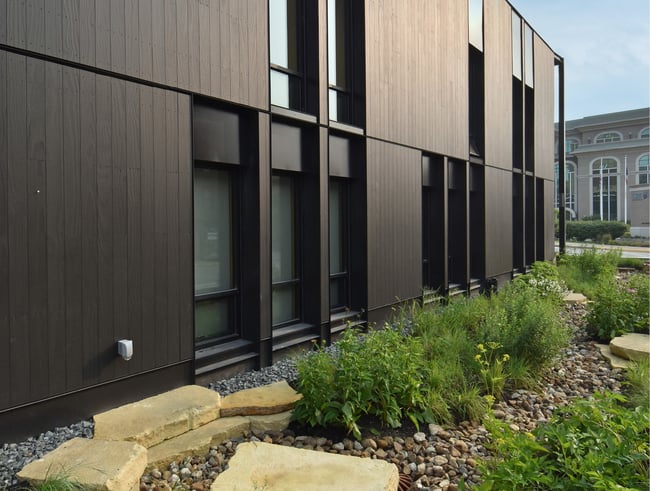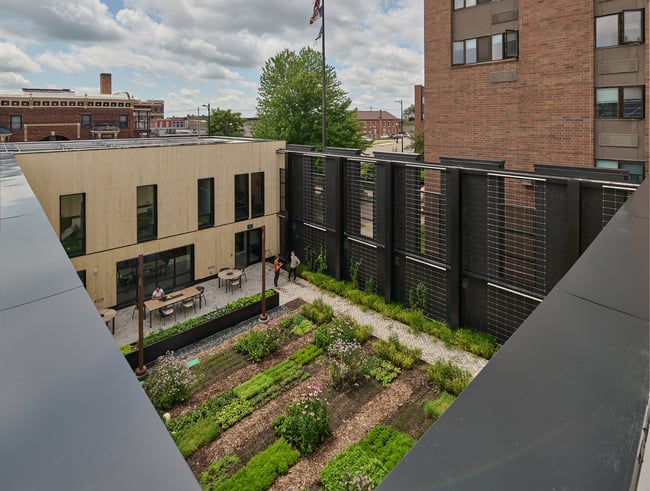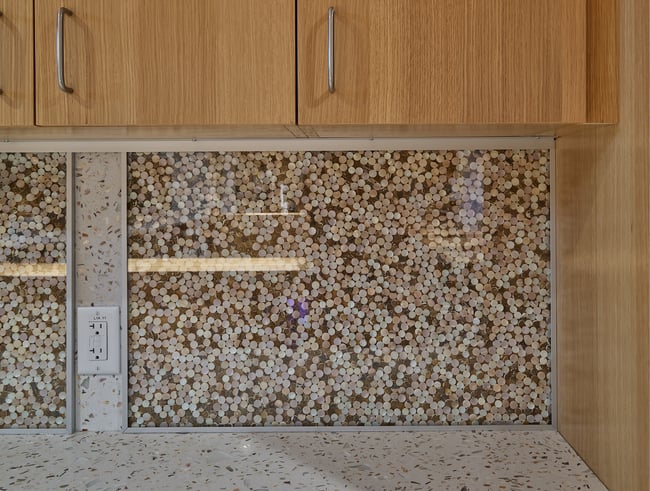Ecology and Community: LBC Place Petal at the Stanley Center

In June 2023, the Stanley Center for Peace and Security opened its new headquarters in Muscatine, Iowa. The project is tracking to achieve a full Living Building Certification, making it one of 36 buildings and the second renovation project to achieve this title.
The Living Building Challenge (LBC) is the most rigorous and holistic building certification system. Its framework is divided into seven categories known as “petals.” These petals include:
- Place
- Water
- Energy
- Materials
- Health and Happiness
- Equity
- Beauty
To celebrate the Stanley Center’s opening, we are discussing how the project fulfills each component of the Petal framework. This article will focus on the Place Petal and explain how the project restores local ecology and strengthens its community.
The Place Petal and Its Imperatives
According to Living Future, the organization overseeing the LBC, the Place Petal seeks to realign how people understand and relate to the natural environment.
It outlines where it is acceptable to build and explains how to restore and protect a site after development. At the same time, it promotes pedestrian-oriented communities supported by local and regional agriculture.
In short, the Place Petal provides a framework for mitigating urban sprawl and protecting natural resources within the built environment. Project teams should strive to understand their site, its history and ecology, and the cultural and social issues impacting the surrounding community.
Each Petal within the LBC framework is divided into separate imperatives. The Place Petal includes four:
- Ecology of Place
- Urban Agriculture
- Habitat Exchange
- Human-Scaled Living
Below, we’ll discuss how the Stanley Center fulfills each imperative.
1. Ecology of Place
The Ecology of Place imperative encourages the ecological regeneration of building sites. When selecting building sites, project teams must avoid green fields, farmland, and wildlife habitats. They must also work to restore the area’s natural flora and fauna.
The Stanley Center chose an existing building site in downtown Muscatine—the former Musser Public Library. The building’s landscaping—designed by Environmental Consulting Technologies—includes a mix of vegetation native to Muscatine County.

Native plantings at the Stanley Center.
These drought-resistant plantings reference the savanna landscape that once dominated the area. They are also pollinator-friendly, benefiting urban agriculture efforts.
2. Urban Agriculture
The Urban Agriculture imperative encourages projects to devote a portion of the building site to food protection to increase the availability of locally grown fresh fruits and vegetables.
At the Stanley Center, 5% of the building site is dedicated to urban agriculture. A portion of the original building was removed to create a courtyard that grows herbs, carrots, sweet potatoes, and alliums—crops tailored to the needs of the Muscatine Center for Social Action (MCSA), a neighboring foodbank.

Urban agriculture space and courtyard.
Salad greens are also grown year-round on interior lettuce walls. These walls provide an enlivening biophilic backdrop, fulfilling multiple goals within the LBC framework.
3. Habitat Exchange
The Habitat Exchange imperative seeks to protect land for other species as more and more land is taken for human use. Projects must set aside land equal to the project area through an approved land trust organization.
Currently, the Stanley Center is working with the Bur Oak Land Trust, a non-profit that protects Iowa’s wetlands, prairies, and woodlands. Projects can also opt to give to the Living Future's land trust program which purchases properties around the globe.
4. Human-Scaled Living
Human-Scaled Living is the Place Petal’s final imperative. It seeks to create walkable, pedestrian-oriented communities that reduce the use of fossil fuels.
The Stanley Center opted not to add any additional surface parking for fossil-fuel vehicles. Instead, it encourages alternative forms of transportation with weather-protected bike racks, storage lockers, and on-site showers. A carpooling program helps further reduce carbon emissions.
The building also enhances the streetscape with trees, native plantings, and retaining walls for respite. A solar array over the neighboring alley provides shade and shelter for MSCA’s patrons.
History and Biophilia
Although the LBC is divided into separate Petals, its framework is interconnected. The Beauty Petal, for example, requires an all-day Biophilia Exploration where participants explore ways to cultivate place-making. The completed project should acknowledge the site’s history and natural landscape.
References to Muscatine’s history can be found throughout the Stanley Center. Interior materials—including a pearl button backsplash and white oak veneers—reference the industries that dominated the area in the early 1900s.

Pearl button backsplash referencing Muscatine's industrial history.
Similarly, a paver pattern at the building’s entrance references a creek that once flowed diagonally across the building site. In the early 1900s, this creek was buried within a brick-lined underground tunnel. Overflow water from the building’s water cisterns flows beneath the entry plaza and into a bioretention cell on the site’s southside.
At the entrance, visitors can also find a cornerstone that marks significant events in the site’s history, including the construction of the original Musser Public Library in 1901, its demolition and replacement in 1971, and the Stanley Center’s renovation in 2021.
Behind the cornerstone lies a time capsule discovered during construction. The Stanley Center added new items before placing the time capsule behind the new cornerstone.
Learn More About the Living Building Challenge
The Living Building Challenge provides a rigorous, verifiable framework for green design and construction. Its Place Petal protects natural resources, reduces urban sprawl, and promotes alternative forms of transportation.
The strategies used at the Stanley Center can apply to any project. Designers and their clients should strive to be more intentional with where they build and how they represent a building site’s history and ecology. Through these efforts, we can cultivate more resilient and vibrant communities.
Each LBC Petal ties into the others, creating a holistic approach to sustainability in the built environment. Learn how the Stanley Center collects and reuses rainwater by reading about the Water Petal.